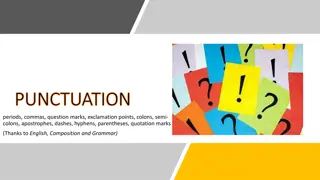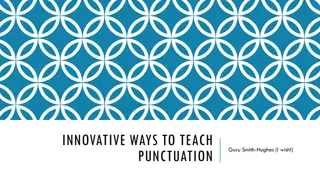Mastering Commas: Your Guide to Punctuation Precision
Dive into the art of utilizing commas effectively with this comprehensive guide that covers using commas to separate items, enclose items, and separate similar items in a series. Explore practical examples and learn when to use commas to separate adjectives before a noun. Enhance your writing skills and avoid confusion by understanding the nuances of comma usage in various sentence structures.
Download Presentation

Please find below an Image/Link to download the presentation.
The content on the website is provided AS IS for your information and personal use only. It may not be sold, licensed, or shared on other websites without obtaining consent from the author.If you encounter any issues during the download, it is possible that the publisher has removed the file from their server.
You are allowed to download the files provided on this website for personal or commercial use, subject to the condition that they are used lawfully. All files are the property of their respective owners.
The content on the website is provided AS IS for your information and personal use only. It may not be sold, licensed, or shared on other websites without obtaining consent from the author.
E N D
Presentation Transcript
FIRST THING FIRST: THURSDAY, OCTOBER 6 You side 5 sentences Walk on the wild Summer SSR BOOK? Friend Misunderstanding Autumn Grandparent Origin of the scar Night Pick one from each column. Write about a memory. Try to show instead of tell.
Today Commas (15-20 minutes) Reader Response Reading Break
COMMAS! A punctuation mark (,) indicating a pause between parts of a sentence. It is also used to separate items in a list.
Before we discuss commas, lets review the types of sentences there are: Note: Every clause has at least a subject and a verb
Conjunctions A conjunction is the part of speech that serves to connect words, phrases, clauses, or sentences For, And, Nor, But, Or, Yet, So FANBOYS
Commas Commas are used to separate items (lists or clauses) or enclose items
Commas that Separate Without commas, some items in a sentence would run into one another, causing confusion or misunderstanding. My favorite foods are pizza, pineapple, peanut butter and eggs.
Items in a Series Three or more similar items together form a series. Ex: I need to buy paper, pencils, and pens. Ex: Did you look in the closet, behind the sofa, and under the bed? Ex: I don t know what time the meeting is, where it is, or what its purpose is.
Adjectives before a Noun Sometimes a comma should separate two adjectives that are not connected by a conjunction: We followed the steep, winding road to their house. adjectives
Easy Way to Know if You Need a Comma If the sentence makes sense with AND between the adjectives, a comma is needed. Ex: Don t lean on that old, rickety table (old AND rickety table reads well) Ex: Don t lean on that old picnic table (old AND picnic table does not read right).
Look at Part I on your Comma Worksheet and Place Commas Where Needed one sentence is 1. Billy Joe can hit well run fast and play left field like a professional. 2. Apples are an inexpensive delicious fruit. 3. The boat rolled and pitched and tossed in the stormy waters. 4. Young growing spiders can regenerate missing legs. correct 5. Hot humid weather does not bother me at all.
Check your answers 1. Billy Joe can hit well, run fast, and play left field like a professional. 2. Apples are an inexpensive, delicious fruit. 3. The boat rolled and pitched and tossed in the stormy waters. 4. Young, growing spiders can regenerate missing legs. 5. Hot, humid weather does not bother me at all.
Compound Sentences Independent clause: a sentence that can stand alone as a complete sentence Compound sentence: A sentence that contains at least two independent clauses. Run-on: two or more main clauses that are not separated by a period or semicolon or joined by a conjunction
Compound Sentences A comma is usually placed before the conjunction in a sentence that joins independent clauses Ex: Come to my house, and we ll study for the test. Ex: The octopus swims forward, but it walks backwards.
Compound Sentences A comma is not needed in a very short compound sentence (fewer than three words on each side) unless the conjunction is yet or for No comma: He left but I stayed. Comma: I waited, for I was curious.
Look at Part II and correct them. One sentence is correct. 1. I made a fire for it was very chilly. 2. My throat was sore and my head was hot. 3. The curtain rose and the play began. 4. It s warm outside yet I feel cold. 5. The earth was once entirely liquid but the surface has cooled into a hard crust.
Check your answers! 1. I made a fire, for it was very chilly. 2. My throat was sore , and my head was hot. 3. The curtain rose and the play began. 4. It s warm outside, yet I feel cold. 5. The earth was once entirely liquid, but the surface has cooled into a hard crust.
Reader Response Title, Author, Page Number Prompt # About a page Read when finished
Using Commas with Introductory Elements Certain words, phrases, and clauses that come at the beginning of a sentence need to be separated from the rest of the sentence by a comma.
Examples of Introductory Elements Why, I think I can be ready at six o clock. Other introductory words: no, now, oh, well, yes
Examples of Introductory Elements After five hours on the plane, I never want to sit down again. A comma comes after a prepositional phrase of more than four words. Prepositional Phrase: indicates various relationships between subjects and verbs *do not place a comma after an introductory phrase that is followed by a verb. Ex: Into the center of the target landed the arrow.
Examples of Introductory Elements Opening my grammar book, I found my missing class notes. Since the day was overcast, I took an umbrella to school with me. In Room 151, 100 people had gathered.
Look at Part III and correct them if needed. 1. Now this is your last chance. 2. Since the invention of Coca Cola only seven people have known its formula. 3. Climbing the steep trail we often had to stop and rest. 4. From here you can see five other states. 5. In 1978 41,216 new books were published in the United States. One sentence is correct.
Check your answers 1. Now, this is your last chance. 2. Since the invention of Coca Cola, only seven people have known its formula. 3. Climbing the steep trail, we often had to stop and rest. 4. From here you can see five other states. 5. In 1978, 41,216 new books were published in the United States.
Commonly Use commas to separate the elements in dates and addresses. used Ex: On Monday, March 9, 1964, my parents were married. commas Ex: Our school s address is 5051 Old Easton Road, Doylestown, Pennsylvania.
Commas that Enclose Use commas to set off nouns of direct address Ex: Randy, do you know who won the game? Use commas for parenthetical expressions Ex: Labor Day, like Thanksgiving, is a legal holiday.
Use commas to identify nouns in the sentence Ex: Mr. Roberts, our track coach, just got married. Ex: We just returned from Albany, the capital of New York.
Look at Part IV and correct them if needed. One is correct. 1. Randy not Stewart won the 100-meter race. 2. The elephant seal by the way is the largest animal in America. Our school just put on the musical Camelot.
Check your answers! 1. Randy, not Stewart, won the 100-meter race. 2. The elephant seal, by the way, is the largest animal in America. Our school just put on the musical Camelot.
Check Your Writing Go through your draft and CIRCLE commas and coordinating conjunctions Check each sentence to see if you need a comma or if your comma is in the correct place.























